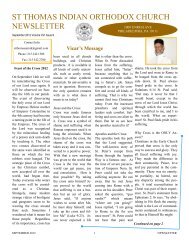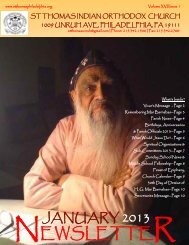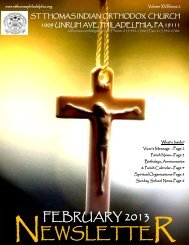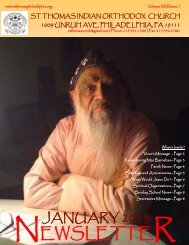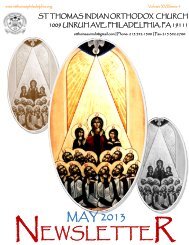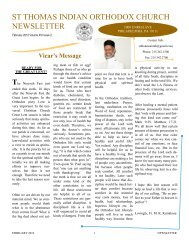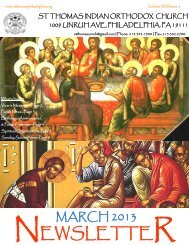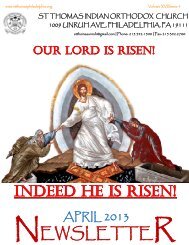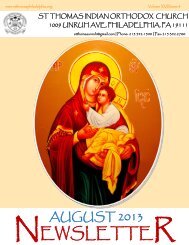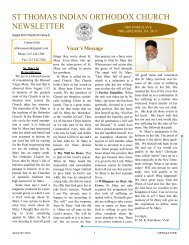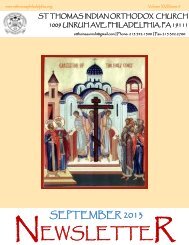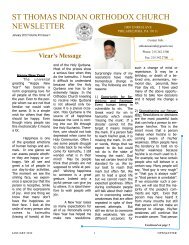Meditation Shrine Brochure - St. Thomas Philadelphia
Meditation Shrine Brochure - St. Thomas Philadelphia
Meditation Shrine Brochure - St. Thomas Philadelphia
Create successful ePaper yourself
Turn your PDF publications into a flip-book with our unique Google optimized e-Paper software.
MEDITATION SHRINE<br />
DEDICATION<br />
<strong>St</strong>. <strong>Thomas</strong> Indian Orthodox Church<br />
By<br />
1009 Unruh Ave, <strong>Philadelphia</strong>, PA 19111<br />
His Grace Zachariah Mar Nicholovos Metropolitan<br />
(Northeast American Diocese) On Sunday, December 23, 2012<br />
1 Sunday, December 23, 2012
The Significance of the <strong>Meditation</strong> <strong>Shrine</strong><br />
Fr. M. K. Kuriakose<br />
The new <strong>Meditation</strong> <strong>Shrine</strong> of our parish is now ready<br />
to use, fulfilling one of my dreams. Not many people are aware<br />
of what the room was used for when we acquired the building. It<br />
was a memorial area of the Jewish community with engraved<br />
memorial plates. The Jewish community removed them at their<br />
exit. I thought it will be an ideal area for us to convert it into a<br />
small meditation room where our people can sit down and quietly<br />
meditate. One of the marks of Orthodox Spirituality is to meditate<br />
with the saints. Therefore we installed the saintly people’s<br />
pictures including that of the Ascending Lord. In addition to the<br />
Lord, the pictures of <strong>St</strong>. Mary, <strong>St</strong>. <strong>Thomas</strong>, <strong>St</strong>. Gregorios, <strong>St</strong>.<br />
Dionysius, His Grace Kuriakose Mar Gregorios of Pamapadi are<br />
installed.<br />
What is the Significance of Icons?<br />
In the Eastern and Oriental Orthodox traditions icons<br />
have a significant place. Icons are not produced as a commercial<br />
product but as artistic expression of spirituality. They are made<br />
with prayer and fasting. The visual presentation of a reality with<br />
contextual significance is seen in presenting the pictures of our<br />
Lord and the saints. It has both artistic and spiritual component.<br />
Icons were normally hand-made but now more photographs are<br />
used in that place. In any case the icons give an experience of<br />
physical presence of the person or event that is portrayed. In the<br />
Orthodox tradition many miracles are attached to icons because<br />
people who are able to meditate in front of an icon have more<br />
realistic meditational experience. In meditation a visual aid is<br />
helpful to enhance the intimacy of one’s devotion. It is not mandatory<br />
for spiritual growth but it will indeed be a harmless tool.<br />
In the Protestant tradition such iconographic spirituality<br />
is absent. In the Roman Catholic tradition the statues of persons<br />
stand as a representation. In the Orthodox it is just the picture. In<br />
the Eastern (Byzantine) Orthodox Tradition the icons are not<br />
made like in popular art forms drawing people with their physical<br />
appearance but without sharp curves and body expressions. The<br />
icon stands as a symbol of the person depicted. In the Malankara<br />
Orthodox tradition mostly the popular form of art is used. This<br />
goes with the Indian artistic tradition of drawing a picture exactly<br />
like the way the person looks. In all these iconic expressions we<br />
can see a spiritual component that is nothing but an experience of<br />
being connected to a spiritual person. If we visit the room of a<br />
worldly-minded teenager we will see photographs of various celebrities<br />
in various kinds of expressions. Most of it will be sensual<br />
or emotional depictions with which they connect themselves to<br />
those people. One can easily figure out what kind of teenagers<br />
they are based on the kind of pictures they decorate their room<br />
with. Often sensuality and violence are attached to almost all<br />
those pictures. In the Christian iconic expressions it is different.<br />
The icons help us look into deep spiritual power that was already<br />
proven in real life. That is a positive power that benefits others. I<br />
am writing this as my own experience than an a theological statement.<br />
What is the Significance of the<br />
Communion of Saints?<br />
In the Orthodox spirituality,<br />
the saints are an important<br />
component as we believe<br />
that they continue to pray<br />
for us. Our life will be complete<br />
only by our communion with<br />
the unseen world of saints who<br />
became stalwarts of faith and<br />
people who took the suffering of<br />
Christ to themselves. Saints are<br />
the historic proofs of living<br />
presence of God in this world. They were successful in obeying<br />
the Lord to the best of their ability. They exemplified Christ in<br />
their life. They denied their self and took the cross of suffering to<br />
fulfill their duty as a true Christian. We all need the company of<br />
such saints whose success stories will inspire us to follow our<br />
Lord to best of our ability.<br />
The communion of saints helps us grow in holiness day<br />
by day. The Lord expects us to grow to the goodness of the Father<br />
God as our Lord taught, “be ye perfect as your heavenly father<br />
is perfect.” It is this holiness that ultimately makes our destiny.<br />
We know that this world is not the final resting place for us.<br />
We will have to leave all our possessions and material riches behind<br />
and join the Lord with the heavenly beings once we go beyond<br />
the earthly life. Our Lord showed the life beyond the curtain.<br />
In the event of the transfiguration, the Lord was able to<br />
show to the apostles how one would be once this life is over.<br />
However, the enemy is overpowering our faith not to believe<br />
such things. The enemy wants our destruction. Whereas God<br />
wants us to acquire eternal life and so the Lord taught us how to<br />
renounce the worldly pleasures and become like children to get<br />
into the Kingdom of God.<br />
The communion of the saints is a positive power that<br />
can heal us and change our life in a positive manner. Our parish<br />
has witnessed several unexplained events including healing of the<br />
believers both physical and spiritual. Some time ago one of our<br />
members saw the image of <strong>St</strong>. Mary in our meditation room area<br />
and asked her husband, “when did you install that picture?” but<br />
the husband replied that such a picture was not installed. It was<br />
later known that she had that vision about the Mother of God.<br />
There were occasions during the Holy Eucharistic service people<br />
had experienced divine intervention. Often they shared those<br />
experiences with me. These experiences are all consolidated in<br />
the <strong>Meditation</strong> <strong>Shrine</strong> of our church.<br />
In Gratitude:<br />
Initially we did not have the financial ability to make the<br />
shrine. Often in our meetings this job was moved from the budget.<br />
I was not courageous to compel our people because many of<br />
our people are not convinced of this aspect of Orthodox spirituality.<br />
But I prayed that a time may come when I can accomplish it.<br />
2 Sunday, December 23, 2012
Why Do We Believe In The Intercession Of Saints?<br />
(By Mr. Oommen Kappil)<br />
Communion of Saints or Intercession of Saints is one of<br />
the core elements of Orthodox faith. Church, which is the<br />
body of Christ, includes the living and the departed. Jesus<br />
said, "I am the resurrection and the life. He who believes in<br />
me will live, even though he dies.” John 11:25. This verse<br />
indicates that even after death, the souls are alive. It is biblical<br />
to believe that they are in constant communication<br />
with God. The departed (which could include our parents<br />
and loved ones) will not stop praying for us just because<br />
they are not in flesh any more.<br />
“The memory of the righteous will be a blessing,<br />
but the name of the wicked will rot.” Proverbs 10:7<br />
“Therefore confess your sins to each other and pray for<br />
each other so that you may be healed. The prayer of a righteous<br />
man is powerful and effective.” James 5: 16<br />
When we request others (living or departed faithful)<br />
to intercede on behalf of us, we are not asking them to<br />
forgive us or save us, rather, we are asking them to pray to<br />
God to forgive us and bless us. Forgiveness and blessings<br />
are coming from God.<br />
Can the intercession of saints make a difference?<br />
Let us examine a few incidents from the Holy Bible:<br />
1. Abraham prays to God to not to destroy the city of Sodom.<br />
Refer to Genesis 18: 20-33. In Verse 28, Abraham asks<br />
God: “Suppose there are only forty-five righteous people<br />
rather than fifty? Will you destroy the whole city for lack<br />
of five?" And the LORD said, "I will not destroy it if I find<br />
forty-five righteous people there." Further, as Abraham<br />
pleads to God, He agrees to spare the city if there are 10<br />
righteous people. This is the power of the intercession of<br />
the saints.<br />
2. At the time of the wedding in Cana, Mary intercedes to<br />
Jesus on behalf of the household when it ran out of wine.<br />
Refer to John Chapter 2. Her faith and intercession leads to<br />
Jesus performing his first miracle during his public ministry.<br />
3. Peter, at the temple gate called ‘Beautiful’ heals the lame<br />
person, saying, “I don’t have gold or silver, In the name of<br />
Jesus Christ, rise up and walk.” Acts 3:6. Here we see God<br />
performing miracles through his disciples.<br />
4. John 20:23. Jesus gave his disciples authority to forgive<br />
the sins of others. They are given the authority by Jesus as<br />
his representatives.<br />
5. Shadow of <strong>St</strong> Peter healed the sick (Acts 5:15);<br />
6. The story of the rich man and Lazarus: Refer to Luke<br />
Chapter 16. The rich man submits his requests to Abraham,<br />
(not to God) to send someone from the dead to preach to<br />
his brothers so that they will be saved.<br />
7. The paralytic person was healed by the faith (and intercession)<br />
of those who carried him to Jesus. Refer to Matthew<br />
Chapter 9.<br />
Those who oppose the intercession of saints often<br />
quote, 1 Timothy 2:5 “For there is<br />
one God and one Mediator between God and men, the Man<br />
Christ Jesus."). They ask, “Why do we need a mediator<br />
other than God?” We consider the saints as the representatives<br />
of God. We do not consider the saints as Gods. We<br />
are requesting the saints to pray for us to Jesus, the mediator.<br />
God is the one who accepts (or sometimes rejects) our<br />
prayers. Intercession of saints is not apart from or against<br />
Christ’s mediation. Otherwise, we cannot pray for each<br />
other.<br />
Even those who belong to some protestant churches<br />
that oppose intercession of saints do pray for others on a<br />
regular basis. They do not say, “You will receive according<br />
to your deeds” and walk away. The prayer on behalf of the<br />
sick is a legitimate intercessory prayer. It is our responsibility<br />
to pray for others. Leave the rest to God.<br />
The intercession is not meant just as a means to ask<br />
for personal favors. <strong>St</strong>. Paul wrote, “Remember your leaders,<br />
who spoke the word of God to you. Consider the outcome<br />
of their way of life and imitate their faith.” Hebrews<br />
13:7. When we remember our spiritual Fathers like Saint<br />
Gregorios of Parumala, we can easily relate to their life.<br />
We too can become holy like Parumala Thirumeni. Intercession<br />
should become an opportunity to consider their<br />
way of life and emulate their path towards holiness.<br />
Conclusion<br />
Our faith in the intercession of saints is supported<br />
by the teachings of the Bible, apostles and the holy fathers,<br />
and by the tradition of our Church. The prayers of the<br />
righteous are effective, as we have seen from the experiences<br />
of Abraham and Mary. It is the responsibility of the<br />
faithful to pray for their spiritual fathers, and it is right to<br />
seek their intercession for God’s blessings and spiritual<br />
growth.<br />
Continued from page 2<br />
And this year with the help our people this dream has come to<br />
reality. I know well that this meditation room was not meant to<br />
make any financial gain. But there is option for people to offer<br />
their gifts to God. Time will prove how this can become a positive<br />
milestone in our parish life.<br />
The very sign that many of our people instantly came up with<br />
donations to complete the project is an indication it will be a<br />
blessing for all. Several people worked hard on this project. I<br />
am avoiding their names only because they are too many and I<br />
am afraid that I may miss some names. The artist Mr. Tiruvalla<br />
Baby did a good design of the room. Several members<br />
offered the pictures of saints, crosses, picture frames, candle<br />
stands, etc. People who did physical labor some way or the<br />
other are to be appreciated. I thank everyone who had their<br />
slice of work on this project. Our special gratitude is due to<br />
His Grace Zachariah Mar Nicholovos, the Metropolitan our<br />
Diocese who graciously agreed to dedicate this room. I just<br />
pray that the Lord bless everyone who worked with this project.<br />
3 Sunday, December 23, 2012
<strong>St</strong>. Mary, Mother of God<br />
Dr.Yuhanon Mar Dimitrios (Metropolitan,Diocese of Delhi)<br />
Among all the saints of the Church, <strong>St</strong>. Mary occupies a preeminent position. This<br />
prominence is the consequence of her role as the Mother of God (Theotokos), a title that was<br />
underscored by the Ecumenical Council of Ephesus (A.D. 431) and firmly establishing it in<br />
the spirituality of the Church. <strong>St</strong>. Mary thus appears not only as the person who was favoured<br />
to bear the Son of God, but because of her acquiescence to God’s offer, she represents the<br />
pinnacle of synergy, the process by which human beings cooperate with God for the advancement<br />
of the salvific plan. Thus, she represents the reversal of the fatal fall of Eve in the Garden<br />
of Eden, and so is also given the designation “the second Eve.” The concept and role of<br />
<strong>St</strong>. Mary in the Malankara Orthodox Church can be appreciated only in the connection with its<br />
Christology and ecclesiology.<br />
While the Holy Scriptures do not contain this information, the Church tradition<br />
names <strong>St</strong>.Mary’s parents as Joachim and Anna, information contained in the Protevangelium<br />
of <strong>St</strong>.James. Her early years are shrouded in silence, except for the generalized picture that she<br />
was resident in the Jerusalem Temple. From this point the New Testament informs us that she received the annunciation of the birth<br />
of the Son of God (Lk 1: 2ff ), a point obliquely stated in <strong>St</strong>. Matthew’s infancy narrative (Mt.1:20) <strong>St</strong>.Luke very succinctly suggests<br />
that many of <strong>St</strong>.Mary’s experiences went past her comprehension, and it was only the passage of time that unpacked their significance<br />
for her (Lk 2:19, 50-51). Both <strong>St</strong>.Matthew and <strong>St</strong>.Luke record that she was affianced to Joseph who belonged to David’s family.<br />
It is in this way that Jesus’ ancestry is ultimately traced to the Davidic line. <strong>St</strong>.Matthew’s narrative <strong>St</strong>.Mt 2:1ff) has King Herod<br />
making an attempt on the life of the young Jesus, occasioned by the arrival and query of the Wise Men. Operating through a divine<br />
revelation, <strong>St</strong>.Joseph takes the mother Mary and the little Jesus and flees to Egypt. A revelation in a dream at a later stage conveys<br />
the death of those who sought the life of Jesus and so <strong>St</strong>.Joseph returns with <strong>St</strong>.Mary and the child to their native country and opt to<br />
settle in Nazareth for fear of Herod’s son who now controlled Judea. <strong>St</strong>.Luke alone records the event of <strong>St</strong>.Joseph and <strong>St</strong>.Mary taking<br />
the young Jesus to Jerusalem to attend the Passover and is somehow lost. After three days the parents return to find Jesus discussing<br />
with the teachers.<br />
We do not glimpse too many occasions when <strong>St</strong>.Mary is sighted during Jesus’ public ministry. There is the anecdote of how<br />
she, accompanied by other family members, attempt to obtain a meeting with him, which Jesus supposedly does not acquiesce to.<br />
<strong>St</strong>.John, however, has the narrative of Jesus, along with his disciples and <strong>St</strong>.Mary attending a marriage feast at Cana and during the<br />
course of which the wine runs out. <strong>St</strong>. Mary intercedes with her Son Jesus, the consequence of which leads to the transformation of<br />
the water held in six stone jars into the most qualitatively superlative wine. We then find references to <strong>St</strong>.Mary only during the last<br />
hours of Jesus when she is numbered among the women who watch his crucifixion. <strong>St</strong>.John has the poignant story of committing her<br />
to the care of his Beloved Disciple, an indication that by this time she had no family to look after her.<br />
The increase in the respect and reverence to <strong>St</strong>.Mary in consequence of her developing faith, which is seen in Acts<br />
of the Apostles, is continued in the early Church. And it is on the basis of the popular devotion to her that the Second Ecumenical<br />
Council held at Ephesus in A.D. 431 declared that <strong>St</strong>.Mary be addressed as the “Mother of God” (theotokos). It must be borne in<br />
mind that <strong>St</strong>.Cyril of Alexandria’s opposition to Nestorius’ advocacy for the use Mother of Christ (christotokos), the controversy<br />
that consitututes the background for this ecumenical council was based not only on this popular piety, but also on the sound theological<br />
principle that what was in question was more than a mere use of a term. What was at stake was the very foundation of the belief<br />
that God had become man. In pursuing the belief that Christ was fully God and fully man, the Alexandrian Church father stressed<br />
that to address <strong>St</strong>.Mary as merely the Mother of Christ alone sundered this unitive concept.<br />
This high reverence for <strong>St</strong>.Mary forms the underpinnings for the Orthodox Church’s hymns which extol her as the Second<br />
Eve and a second heaven. Many of the hymns use the events of the Old Testament to interpret the mystery of how God could have<br />
become a human through the agency of <strong>St</strong>.Mary. For instance, a favourite event is to interpret the appearance of God to Moses in the<br />
burning bush as a type of how Christ was incarnated; just as God appeared as a fire in the bush, but the bush was not consumed, so<br />
also Christ was born of <strong>St</strong>.Mary without consuming her. And since Christ is borne by the Cherubim in heaven, so also <strong>St</strong>.Mary is<br />
figured as a second heaven because she bore the Son of God. In all these instances, what is stressed is <strong>St</strong>.Mary’s obedience and submission<br />
to the will of God, thus reversing the disobedience and self-oriented character of the first Eve which paved for humankind’s<br />
fall into sin.<br />
The Orthodox Church holds it as part of its faith article that <strong>St</strong>.Mary continued to be a virgin all her life, addressing her as<br />
the Virgin Mary or the Virgin Mother. It believes that the Holy Scriptures do not contradict this belief and interprets the statements<br />
4 Sunday, December 23, 2012
APOSTLE OF INDIA - ST. THOMAS<br />
<strong>St</strong>. <strong>Thomas</strong>, known by other names Judas <strong>Thomas</strong> or Didymus, who was one of the<br />
twelve disciples of Our lord Jesus Christ, is the Apostle of India and the guardian & father of Malankara<br />
Church. In the list appeared in the Synoptic Gospels and Acts he is referred as 'Twin'. As per<br />
the witness of <strong>St</strong>. John, it is Apostle <strong>Thomas</strong> who said bravely at Bethany, "Let us also go, that we<br />
might die with him". Being humanly logical, <strong>Thomas</strong> doubted the resurrection of Jesus and demanded<br />
to touch Jesus' wounds before being convinced. After seeing the risen Christ with his own eyes<br />
and by touching His wounds, <strong>Thomas</strong> professed his faith in Jesus, exclaiming "My Lord and my<br />
God!"<br />
In the light of traditions which have a great deal of history to back them up, we believe that<br />
<strong>St</strong>. <strong>Thomas</strong>, the Apostle, landed in Crangannore which is a coastal harbor city in Kerala, India, in 52<br />
A.D. The Legend described in the Acts of <strong>St</strong>. <strong>Thomas</strong> relates the mission of <strong>St</strong>. <strong>Thomas</strong> in India.<br />
Gundafor, a first century king in India, wanted to build a palace and sent his envoy Abban to Jerusalem in search of an Architect. By<br />
the guidance of providence, Abban brought <strong>Thomas</strong> as a carpenter for his master. Coming to India <strong>Thomas</strong> undertook to build a<br />
palace for Gundafor, but spend the money entrusted to him for the poor. Asked to show his progress, <strong>St</strong>. <strong>Thomas</strong> explained that the<br />
palace he was building was in heaven, not on earth. Angry Gundafor imprisoned <strong>Thomas</strong>. By this time, Gad, the brother of the king<br />
expired and he appeared in a vision to the King and told it is really true that the mansion entrusted to <strong>Thomas</strong> is being built in heaven.<br />
The King believed in <strong>Thomas</strong> and released him from prison. Now the coins and stone-inscriptions received in Archeological excavations<br />
reveal that King Gundafor was undisputedly ruled in India during the first century. Our Church believes this legend and<br />
teaches in our Sunday school lessons.<br />
He converted high caste Hindu families and consecrated priests. He built churches and erected cross. These Christians became<br />
the foundation of the Church in India and are known as <strong>St</strong>. <strong>Thomas</strong> Christians. Towards the end of his life, <strong>St</strong>. <strong>Thomas</strong> pushed<br />
his missionary journey towards east coast near Madras. Apostle was murdered with a lance by a low caste fanatic, while the saint<br />
was praying, at Little Mount, a hill in Mylapur, in 72 A.D. His body was brought to Mylapore and was buried there. The entire relics<br />
are known to have removed from India to Edessa and later to Ortona in Italy.<br />
Various writings such as the Acts of <strong>Thomas</strong>, the Apocalypse of <strong>Thomas</strong>, the Gospel of <strong>Thomas</strong> and the Infancy Gospel of<br />
<strong>Thomas</strong>, dating from the 2nd to the 4th centuries, are linked with name of <strong>St</strong>. <strong>Thomas</strong>. Some of them are apocryphal and some are<br />
considered Gnostic in origin. Christians all over India celebrated the 19th centenary anniversary of the arrival of <strong>St</strong>. <strong>Thomas</strong> in 1952.<br />
Government of India had officially honored the blessed memory of <strong>St</strong>. <strong>Thomas</strong> and depicted his picture on Indian Postage <strong>St</strong>amp in<br />
1972. Our Father <strong>St</strong>. <strong>Thomas</strong> is remembered in the fourth Thubden in every Holy Qurbana and celebrates his feast on July 3, every<br />
year. Many of the Churches of Malankara Orthodox Church are dedicated to the patronage of <strong>St</strong>. <strong>Thomas</strong>.<br />
Continued from Page 4<br />
in the New Testament to the brothers and sisters of Jesus as either referring to brothers and sisters born to Joseph through a previous<br />
marriage or his cousins. Indeed, the New Testament could be seen as very supportive of affirming the continued virginity of<br />
<strong>St</strong>.Mary. When Joseph and Mary go up to Jerusalem and inadvertently leave Jesus behind in the Temple, there is no mention in the<br />
gospel to any of his siblings who accompanied them. And in the Gospel of <strong>St</strong>.John, Jeus hands over charge of his mother Mary to<br />
his Beloved Disciple, a situation which would have been unwarranted if Jesus had other brothers or sisters.<br />
However, it must be also stated that in the devotion of the Orthodox Church to <strong>St</strong>.Mary no role or description is made other than<br />
her being the Mother of God. In the iconographic tradition of the Church, <strong>St</strong>.Mary is usually presented as holding in her arms the<br />
child Jesus. Similarly, in the hymns which focus on <strong>St</strong>. Mary, she is asked to intercede to her Son, affirming the biblical principle<br />
that there is only one Mediator between God the Father and humankind. In fact, constant stress of the Church is on the fact that<br />
there is only one person, Jesus Christ, who has been exempt from the taint of humankind’s sin. It can, therefore, be inferred that the<br />
Orthodox Church does not believe that <strong>St</strong>.Mary was immaculately conceived or that she has a special mediatory role alongside Jesus<br />
Christ in the salvation of humankind.<br />
In thus developing a devotion to <strong>St</strong>.Mary the Orthodox Church extols her who exemplifies what it means to be transformed into the<br />
image and likeness of Jesus Christ. No doubt <strong>St</strong>.Mary symbolizes what it means to find favour with God. And in so praising her,<br />
the Church recognizes that it fulfills <strong>St</strong>.Mary’s prediction given in the Magnificat:<br />
“For, behold, henceforth all generations will call me blessed ” (Lk 1:48).<br />
5 Sunday, December 23, 2012
ST. GREGORIOS OF PARUMALA<br />
Saint Gregorios of Parumala is popularly known as<br />
‘Parumala Thirumeni’. Metropolitan Geevarghese Mar Gregorios<br />
of the Malankara Orthodox Church who passed away on November<br />
2nd 1902, became the first declared saint from Malankara<br />
(Kerala, India) naturally to be called, ‘Parumala Thirumeni’. He<br />
shines in the cloud of witnesses as a bright luminary giving rays<br />
of hope to millions in their suffering and struggles.<br />
Mar Gregorios was born on 15th June 1848 (M.E.<br />
Mithunam 3, 1023) to Kochu Mathai and Mariam of Pallathetta<br />
family in the Chathuruthy house at Mulamthuruthy. He was<br />
called by the name ‘Kochaippora’ and was given the baptismal<br />
name ‘Geevarghese’. Kochaippora had two brothers and two<br />
sisters; Kurian, Eli, Mariam and Varkey. Kochaippora was the<br />
youngest and was therefore the most beloved to everyone. Unfortunately,<br />
his mother passed away when he was only two years<br />
old. His eldest sister Mariam became to him all that a mother was<br />
meant. Mariam was married at that time and had a child of<br />
Kochaippora’s<br />
age.<br />
He was ordained as a reader-deacon (Korooyo) on 14th<br />
Sept, 1858 at the age of ten by Palakkunnath Mathews Mar Athanasios<br />
at Karingachira Church. Koroyo Geevarghese continued<br />
his training under Geevarghese Malpan until the latter died due<br />
to small pox. Although Deacon Geevarghese was also infected<br />
with small pox, he miraculously survived it. Afterwards Deacon<br />
Geevarghese moved to Pampakuda to continued his studies under<br />
Konat Geevarghese Malpan. In the mean time Deacon became<br />
associated with the visiting Syrian Bishop Yuyakim Mar Coorilos.<br />
Mar Coorilos had great admiration for the deacon and was<br />
pleased to ordain him as full deacon, priest and cor-episcopa<br />
within few months in 1865.<br />
The new priest’s short stay at Mulanthuruthy Marthommen<br />
Church gave him an inner conviction that he should<br />
lead a hermit’s life in a quieter place. Therefore he shifted his<br />
residence to Vettickal Dayara. At Vettickal Dayara, Corepiscopa<br />
Geevarghese started a strenuous life of prayer and fasting. Having<br />
heard about the vigorous asceticism practised by corepiscopa<br />
Geevarghese, the then Malankara Metropolitan Pulikkottil Joseph<br />
Mar Dionysius made him a ‘Ramban’ (Monk Priest) in 1872.<br />
Being pleased with the Ramban Geevarghese, the Patriarch<br />
decided to consecrate him as Metropolitan. On December<br />
10, 1876 the Patriarch consecrated six priests as bishops including<br />
Ramban Geevarghese at <strong>St</strong>. <strong>Thomas</strong> Church, N Paravur. He<br />
was given the new name Geevarghese Mar Gregorios and was<br />
given the charge of Niranam Diocese. Mar Gregorios was only<br />
28 years when he was made a bishop. Since he was the youngest<br />
among all the bishops, he was dearly called by all as ‘Kochu<br />
Thirumeni’. The first thing the new bishops undertook was a<br />
special fasting-vigil for forty days at Vettickal Dayara under the<br />
leadership of ‘Kochu Thirumeni’. This fasting was both symbolic<br />
and effective in the pursuit of new life in an old church.<br />
Mar Gregorios took charge of the Niranam Diocese and started<br />
staying at Parumala. There was at Parumala, at that time, a land<br />
donated by Arikupurath Koruth Mathen to the church and in this<br />
plot a small building<br />
was erected by the<br />
Malankara Metropolitan<br />
Pulikkottil Joseph<br />
Mar Dionysius. This<br />
building was known<br />
as ‘Azhippura’. Mar<br />
Gregorios lived there<br />
along with few other<br />
deacons who came for<br />
priestly training. They<br />
worshipped in a<br />
thatched chapel during<br />
that time.<br />
Mar Gregorios<br />
engaged in a threefold<br />
activity of tireless<br />
service for the church:<br />
Diocesan administration, Ministerial formation of deacons, Missionary<br />
witness of the church through inner spiritual and theological<br />
consolidation, along with evangelical reaching out. In addition<br />
to these, Mar Gregorios undertook the task of building a<br />
church and seminary at Parumala. The diocesan administration,<br />
in the mean time, was extended to two more dioceses,<br />
Thumpamon and Quilon. The newly constructed church was consecrated<br />
in 1895. Mar Gregorios was the co-celebrant for the<br />
consecration of two ex-Roman Catholic priests as bishops:<br />
Fr.Alvaris as Alvaris Mar Kulius for Bombay-Mangalore Diocese;<br />
Fr.Rene Vilatti as Rene Vilatti Mar Timotheos for America.<br />
. Mar Gregorios believed that the church should engage<br />
in educational activity especially to facilitate primary education<br />
and English teaching without discriminating gender or religion.<br />
Accordingly he started schools at Kunnamkulam, Mulamthuruthy,<br />
Niranam, Thumpamon, Thiruvalla etc. The missionary<br />
task of the Church was also evinced by his outreach programme<br />
to the socially down trodden communities at Chennithala, Kalikunnu,<br />
Mallappally, Puthupally, Kallumkathara etc. He also<br />
organized evangelical awakening programme for non-Christians<br />
at various places like Aluva, under the leadership of the Seminary<br />
students.<br />
A major task of Mar Gregorios was to motivate the clergy for<br />
effective ministry. With this aim, he formed the Malankara Syrian<br />
Clergy Association and took many progressive decisions and<br />
made many suggestions for the effective functioning of the<br />
priestly ministry.<br />
Mar Gregorios was already a piles-patient. It became<br />
chronic in 1902. Treatments proved futile and slowly His Grace became<br />
physically weaker and weaker. At last the blessed soul left the<br />
earthly abode on 2nd November 1902. The funeral was conducted at<br />
Parumala on Tuesday the 3rd of November 1902 in the presence of<br />
thousands of people and hundreds of priests. The many testimonies<br />
to the saintly intercession of Mar Gregorios made Parumala Church<br />
and the tomb a centre of pilgrimage. In 1947 Mar Gregorios of<br />
blessed memory was declared a saint by the then Catholicos of the<br />
church, His Holiness Baselius Geevarghese II.<br />
6 Sunday, December 23, 2012
<strong>St</strong>. Geevarghese Mar Dionysius Vattasseril<br />
<strong>St</strong>. Geevarghese Mar Dionysius Vattasseril, Malankara<br />
Metropolitan, was a bright light for the Malankara Orthodox Syrian<br />
Church that illumined during her dark and tumultuous times<br />
and possessed the vision to bring the Church triumphantly from<br />
the bonds of foreign oppression. Thirumeni dedicated his entire<br />
life to secure the freedom and welfare of the Holy Church. His<br />
Grace faced many troubles and obstacles as well as received constant<br />
physical and verbal abuse via threats and physical attacks as<br />
he courageously led the Church to her independence. He confronted<br />
the dangers and obstacles directly responding with vigor,<br />
strength and remarkable conviction and confidence in God’s justice<br />
and plan, which was a product of his continual fasting and<br />
prayer. God protected Thirumeni throughout his life whether in<br />
Kerala or abroad as he sought the freedom of the Church from<br />
foreign powers. His great triumph lay in the ability to unite the<br />
entire Church, both the priests and laymen to follow his lead. He<br />
was incredibly gifted in many fields, a multifarious genius. He<br />
was a spiritual leader, a theological educator, scholar of languages,<br />
literature and traditions. He was a dignified, valorous<br />
and noble personality with a remarkable commanding power.<br />
<strong>St</strong>. Dionysius was born to his parents, Joseph Vattasseril<br />
of Mallappally and Eliamma Kolathu Kalathil of Kurichy on 31st<br />
October 1858. Following his elementary education at C. M. S.<br />
Middle School in Mallappally he completed his high school education<br />
from C. M. S. High School, Kottayam. In 1876, while still<br />
a high school student, he was ordained as a sub deacon by H. H.<br />
Moran Mar Pathrose Patriarch.<br />
Dn. Geevarghese studied at the Orthodox Theological<br />
Seminary (Old Seminary or Pazhaya Seminary), Kottayam for<br />
four years thereby undergoing his theological training. Dn. Geevarghese<br />
soon became a great Syriac scholar under the careful<br />
tutelage of <strong>St</strong>. Gregorios of Parumala, who taught him at Seminary.<br />
In 1879 Dn. Geevarghese was ordained as a full deacon<br />
and in 1880 he was ordained as a priest by <strong>St</strong>. Gregorios. By<br />
1880, Fr. Geevarghese had become an authority in the Syriac,<br />
Church History, Faith and Doctrine, the Church Fathers, and<br />
Theology. In recognition of his incredible expertise in Syriac<br />
and theology he was designated as Malankara Malpan. He spent<br />
his spare time reading, studying, and thinking which translated to<br />
his many renowned writings such as “Doctrines of the Church”.<br />
He also used his scholarship to edit and publish the order of<br />
Church worship to be used by the ordinary faithful for meaningful<br />
participation in worship. He was appointed as Principal of M.<br />
D. Seminary, Kottayam as he was both a great scholar and administrator.<br />
In 1903, he was blessed as a Ramban (monk). He<br />
also served as the Manager of Parumala Seminary. In 1908 he<br />
was consecrated as H. G. Geevarghese Mar Dionysius Metropolitan<br />
and served as the Assistant Malankara Metropolitan. The<br />
next year he became the Malankara Metropolitan and served and<br />
led the Church in that capacity until his departure from this life in<br />
1934 when he and the Church triumphed in establishing the official<br />
constitution of the Malankara Orthodox Syrian Church.<br />
H. H. Moran Mar Baselios Geevarghese II Catholicos of<br />
blessed memory remarked in the speech at the burial of Vattasseril<br />
Thirumeni, “When we look at the highest solemn position<br />
held by Vattasseril Thirumeni and his deep and firm faith in God,<br />
he seemed similar to Moses who led the sons of Abraham from<br />
the captive land of Egypt to the promised land of freedom and<br />
happiness. There is no doubt about it. Moses had spent his entire<br />
life for the freedom of his people but he could not enter the<br />
Promised Land. He was only able to see the Promised Land from<br />
a distance. Likewise the Moses of the Malankara Church has<br />
also watched the freedom of his Church from a distance”. Vattasseril<br />
Thirumeni was a good orator who was well aware of the<br />
importance of the vitality and moral persuasiveness of words<br />
when delivering the speeches to the faithful. Spiritually, he was<br />
transformed by Christ and bore no scars from sin. His humility<br />
and withdrawal from the praise of this world kept many from<br />
seeing the incredibly pious and faithful life that Thirumeni lived.<br />
In addition to not publicizing his own spiritual advancement he<br />
also avoided spiritual hypocrisy and arrogance throughout his<br />
life. Prayers and fasting were the pillars that were Vattasseril<br />
Thirumeni’s spiritual foundation. He faced all the challenges<br />
with the power he had gained through his valued spiritual life. In<br />
addition to the liturgical hours of prayer, Thirumeni spent much<br />
time in private prayers and silent meditations behind closed doors<br />
and away from the attention of people. In spite of his busy<br />
schedule, he was also able to focus on three to four lessons from<br />
the Holy Bible everyday. Despite Vattasseril Thirumeni’s literal<br />
application of Christ’s instruction to pray in private and not for<br />
others to see, many recognized that His Grace was a living saint<br />
amongst them.<br />
7 Sunday, December 23, 2012
Kuriakose Mar Gregoriose (Pampady Thirumeni):<br />
A Personal Reflection<br />
Rev. Fr. M. K. Kuriakose,<br />
Knowing the limitations of reflecting on a person whom I never met I am making<br />
this humble attempt to express my personal feelings. I am hesitant to touch upon the<br />
life of a saintly person because it is impossible to fathom the spiritual depth of anybody.<br />
In the case of Pampady Thirumeni this attempt is simply a personal witness<br />
of how we the Orthodox reflect on lives of saints and help ourselves and others to<br />
reach the heights that other saints climbed.<br />
I am indebted to two authors who brought light to my life, first Prof. K. M. Kuriakose<br />
and second Mr. K. V. Mammen who through their books allowed me to open<br />
my eyes to a saint's life. I heard some anecdotes from different people about His<br />
Grace. One day His Grace Mathews Mar Barnabas Metropolitan of the American<br />
Diocese shared the incident of Pampady Thirumeni's love of animals and the way<br />
they responded to him. The incident was that of the female dog that used to come<br />
to the Aramana (bishop's residence) everyday. The pregnant dog did not appear for<br />
a few days during the confinement and one day it returned to the Aramana. His<br />
Grace asked, "where are your babies?" The dog instantly went and brought one of<br />
its babies in its mouth and left in front of the bishop. I later searched for books on<br />
His Grace and found the above authors.<br />
My reading progressed and my life changed slowly. Let me express three of the major points I learned and that which I am trying to<br />
practice in my life.<br />
1. Humility in Real Life:<br />
His Grace has shown utmost humility in all aspects of life. Whether it is towards his teacher a Hindu or to the members of the General<br />
Body of the parishes, His Grace dealt with them soberly and gently. His Grace could solve problems in parishes not with arrogance<br />
and administrative power but with humble approach. Often people with humility are considered weak. Pampady Thirumeni<br />
proved that humility is strength.<br />
2. Faith-filled Courage in Real Life:<br />
His Grace faced life without any fear of consequences because he knew that God is in charge. Even when His Grace did not have<br />
much to eat at the Aramana, he gave to the needy from what he had. The incident of giving away a little measure of rice that is kept<br />
of dinner to a beggar, shows his courage to give to others ignoring one's own needs. But God provided His Grace with more than<br />
what he gave to others. I learned this truth more powerfully from His Grace. True faith is true courage.<br />
3. Respond to Evil with Good:<br />
It is a rare thing to see in the world of today. All problems begin when people use evil means to respond to situations to solve problems.<br />
From the Church's court cases to parish administration, there is severe tendency in the minds of people to retort using evil<br />
ways. Pampady Thirumeni will not respond any evil with an evil response instead, His Grace would pray over the matter and take<br />
the suffering. Goodness cannot be destroyed because goodness is from God. No one can kill God and so is the case with goodness.<br />
Temporarily goodness may appear to be losing but those who can suffer to the end will be victorious. Often I have taken a lot of<br />
abuse from many people because I did not respond evil with evil. Most of our people are revengeful. I used to have the same mentality<br />
but fortunately I got enough strength when I read from Pampady Thirumeni to take a soft approach to problems. Many considered<br />
it a weakness. I don't worry about convincing people about it because people do not think spiritually. Most of our people are trained<br />
in the worldly demeanour system that is alien to Christ.<br />
I hope many will read from this great saint and convey that simplicity and truthfulness to others as well. I used to read a small portion<br />
from His Grace's biography just before night. Often I slept with tears still rolling down from the eyes but when I woke up I had<br />
an inexplicable joy and peace to begin the way with hope and trust in God.<br />
I am happy that I could share these feeling with other members of the Indian Orthodox Church about what I learned from a saintly<br />
bishop of our Church. Hope God will raise many more bishops of the same kind.<br />
8 Sunday, December 23, 2012



